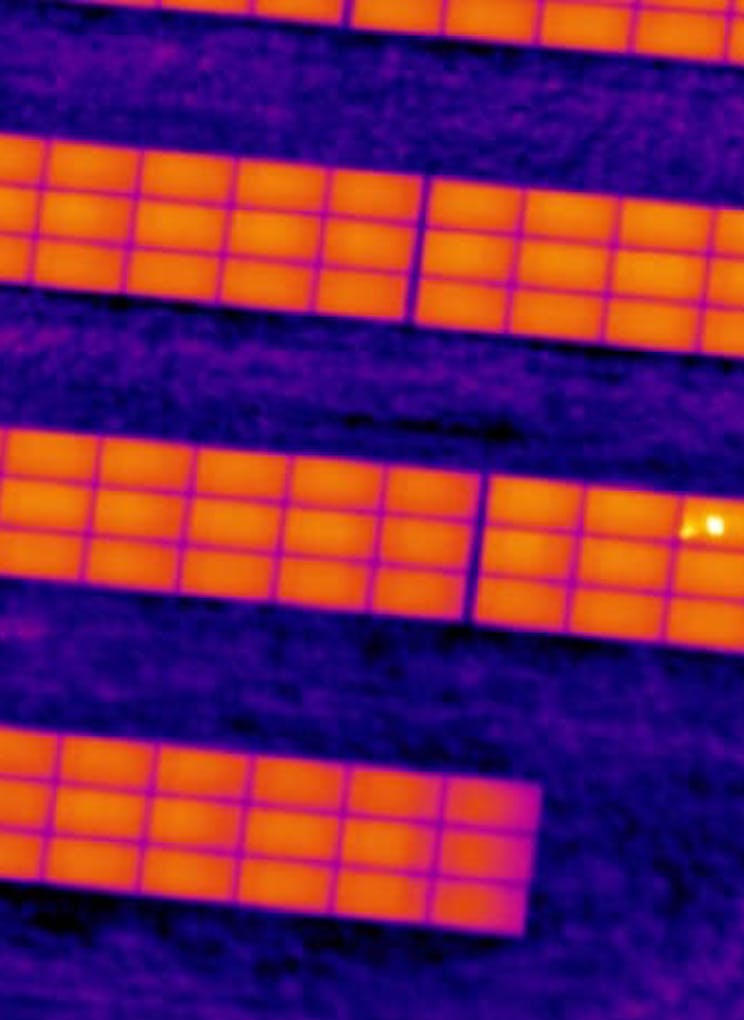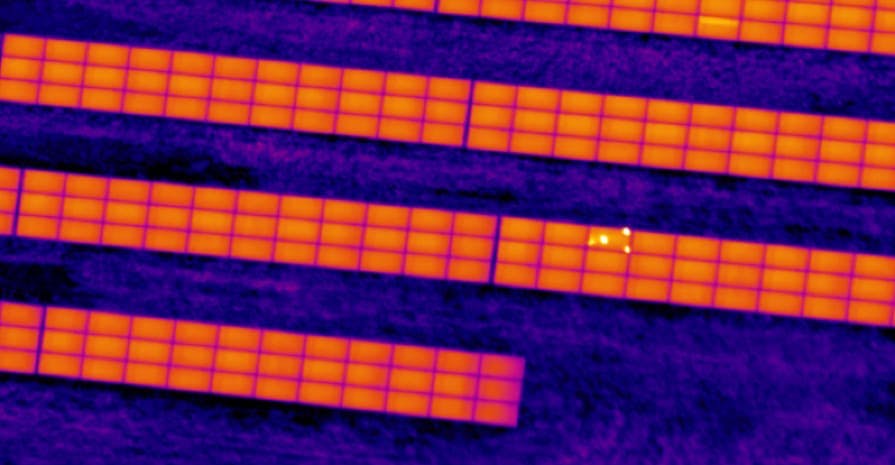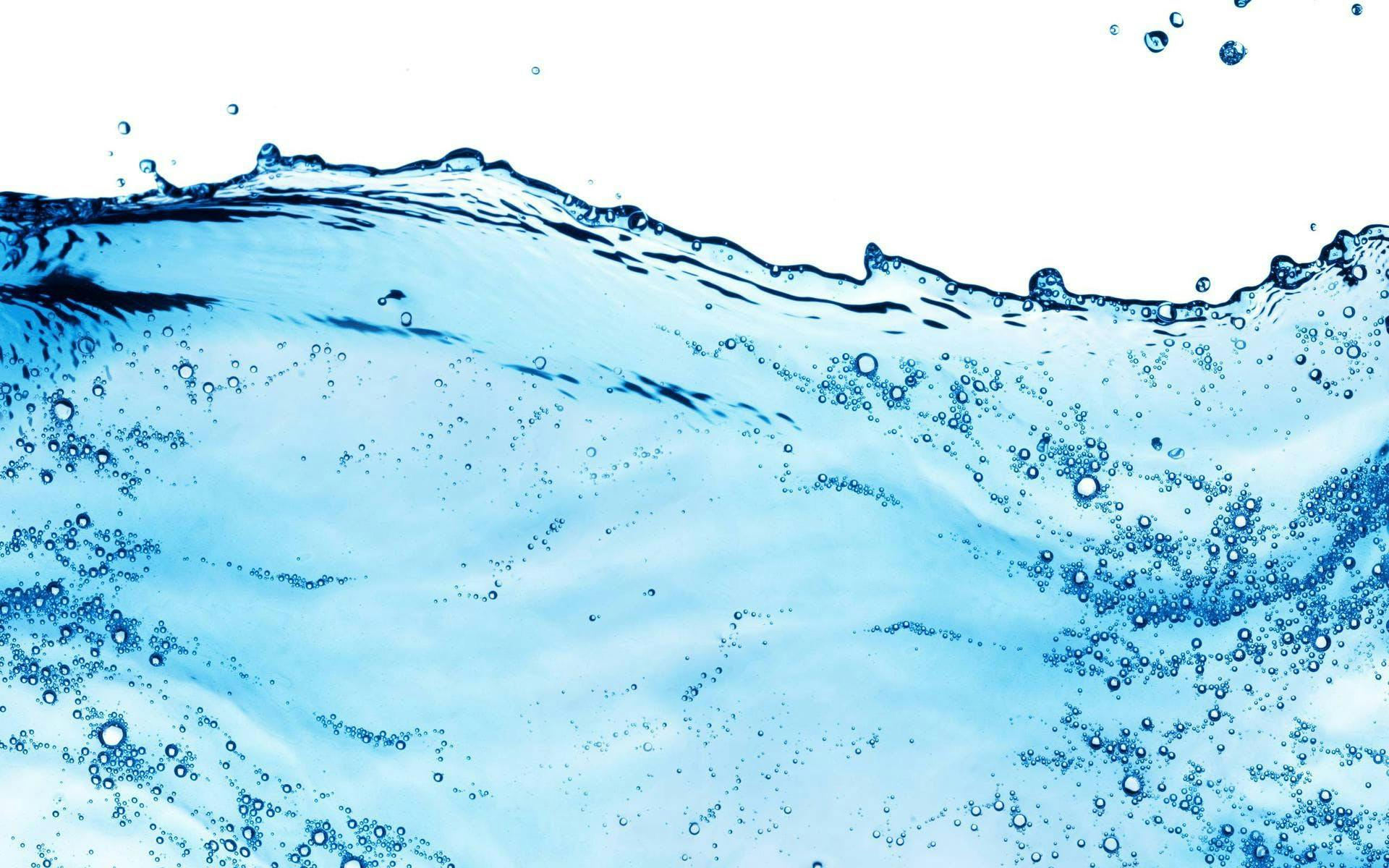R. Dr. Francisco Sá Carneiro
Zona Industrial de Bouro, Letra C
4740-010 Esposende, Portugal
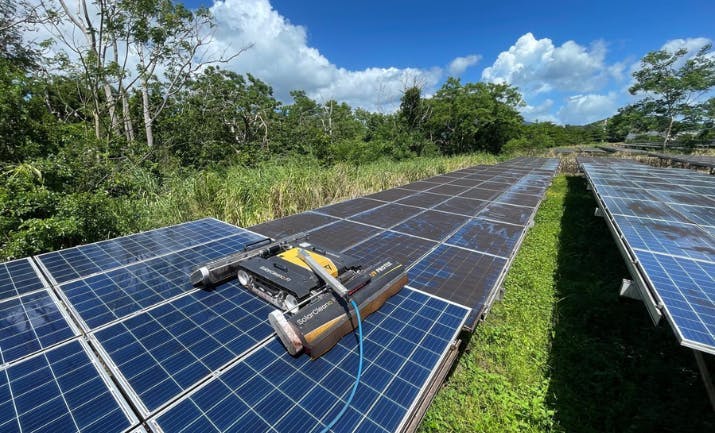
Cleaning Solar Panels: Top 5 Soiling Challenges
Talking about solar energy production is much broader than just talking about solar panels or innovation, it is much more than that; it is also about maintenance, specifically the delicate task of cleaning solar panels.
In the quest to harness solar energy, solar panels are at the forefront, silently battling an implacable enemy - soiling.
In this article, we look at the 5 main culprits, in our view, that cause concerns about the efficiency of solar modules: lichens, fungi, cement dust, bird droppings and general dust/environmental pollution.
Navigating the solar cleaning journey: Myth vs. Reality
Before we discover the 5 biggest challenges of soiling on solar modules, let's address the widespread myths surrounding solar panel cleaning. A common misconception is that rain is enough to keep solar panels spotless. However, the reality is much more complex. Rainwater, although useful, often leaves residues that accumulate over time, affecting the efficiency of the panels.
Another myth revolves around the idea that cleaning solar panels is a simple task. In fact, a delicate balance is required - removing the soiling while making sure not to cause damage. Abrasive materials, scrapers, aggressive scrub pads and other incorrect cleaning techniques will scratch the surface and degrade the modules’ components (e.g., aluminum frame, silicone seals and the anti-reflective coating), diminishing the modules' performance and lifetime.
The importance of following the manufacturer's guidelines
It is essential to follow the manufacturer's guidelines for cleaning solar panels. Each solar panel is a precision-engineered piece of technology, and maintaining its integrity is critical. Manufacturers provide specific instructions on cleaning methods, frequency and materials allowed to clean with to ensure optimum performance.
Disregarding these guidelines not only puts energy production at risk but will also void warranties. The seemingly mundane task of cleaning becomes a critical factor in maximizing the useful life and efficiency of solar modules.
Top 5 soiling challenges:
Lichens: Invaders of humid places
Lichens are unique organisms that result from a symbiotic relationship between fungi and algae. In the context of solar panels, they appear as green or white patches, or as crusty or leaf-like growths, they have specialized structures called rhizines or holdfasts that anchor them to surfaces. These structures can penetrate and adhere to the surface of the solar panels.
Lichens thrive in environments with higher humidity. When moisture is present, lichens can absorb water, promoting their growth and attachment to surfaces. This is why they are often found in more humid regions.
Lichens not only physically block sunlight from reaching the photovoltaic cells but also introduce moisture, promoting the growth of other microorganisms. Their intricate structure makes them tenacious, and their removal requires specialized techniques to avoid damaging the panel surface, requiring specialized cleaning methods.
It is important to use cleaning techniques that do not damage the solar modules, avoid scratching or damaging the surface of the panel.
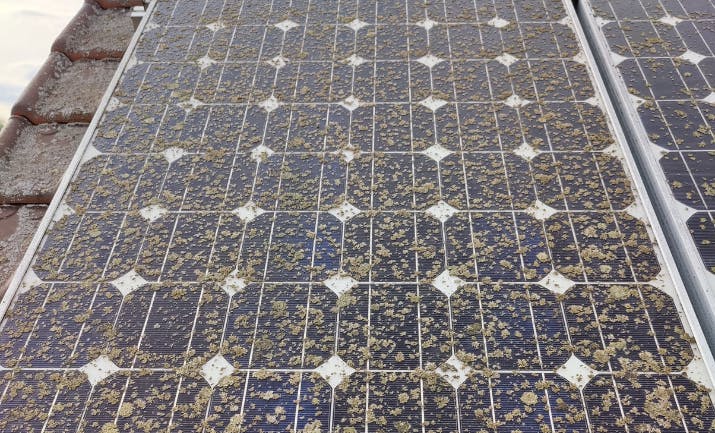


Fungi: microscopic threat
Fungi, microorganisms that thrive in warm and humid environments. On solar panels, they manifest as dark, reddish or discolored spots, indicating their presence and growth.
Fungi reproduce via microscopic spores that can be carried by the wind. These spores may settle on the surface of solar panels, initiating the growth of fungal colonies.
In regions with such climates, especially in equatorial zones, the favorable environmental conditions encourage the growth and establishment of fungi on solar panels.
Fungi can grow rapidly, covering large areas of solar panels if left untreated. Their uneven growth on the panels will promote the appearance of hotspots, which can lead to permanent damage. Their growth can extend beyond the visible areas, making thorough cleaning of this contaminant a challenge if the proper techniques have not been used. Its elimination requires careful cleaning to prevent re-growth and preserving the delicate surface of the panels.
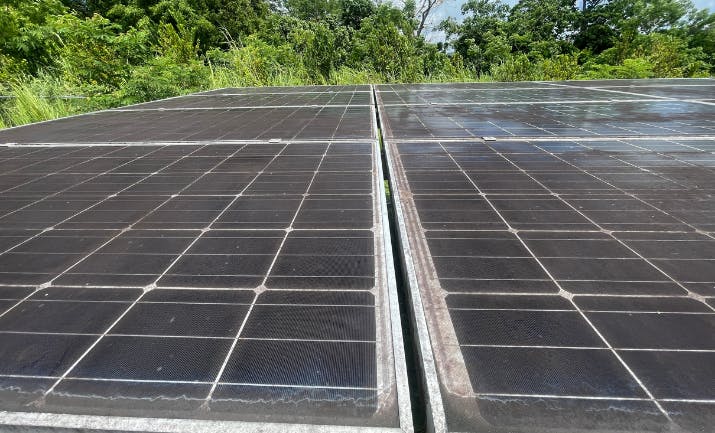


Cement dust: One of the biggest enemies of panels
Cement dust consists of very fine particles that can easily become airborne. These particles can settle on solar panels and work their way into tiny surface imperfections, making them more challenging to dislodge during cleaning.
Cement dust particles, can develop an electrostatic charge, causing them to adhere more strongly to surfaces. This electrostatic attraction can make the dust cling to the solar panel, increasing the difficulty of removal.
The sandy nature of cement dust poses an additional challenge, as its abrasive quality can increase the risk of scratching the glass surface, making the cleaning process much more delicate. Another problem is that this contaminant is quite difficult to remove, once it has cured on the panel, it will be necessary to use a specific agent to break down the cement particles on the module's glass. Cleaning strategies must take this abrasiveness into account to avoid unintentional damage.
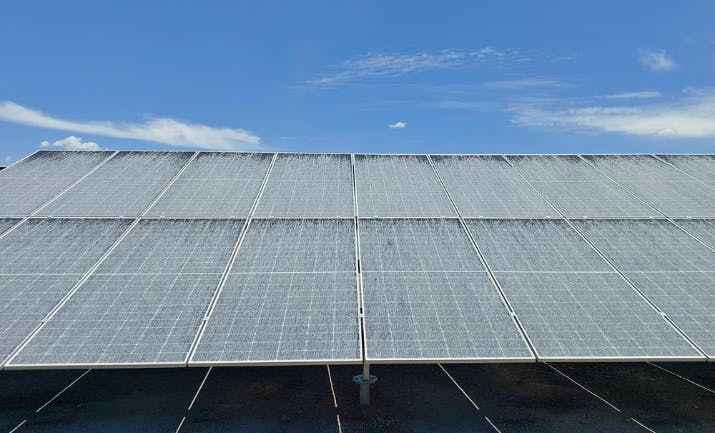

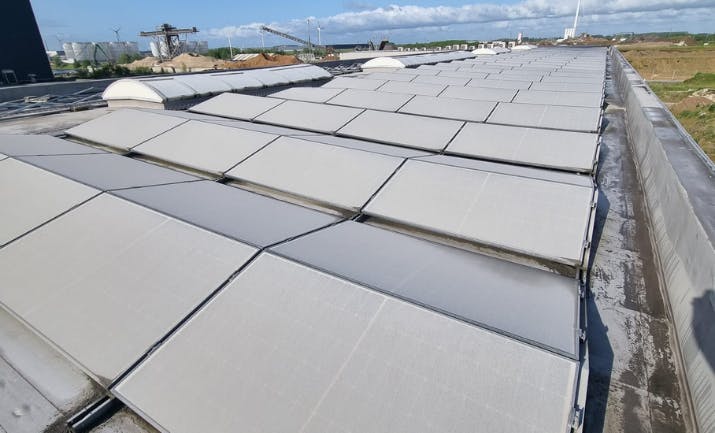
Bird Droppings: A Corrosive Culprit in the Skies
Bird droppings, often overlooked as a minor nuisance, pose a significant threat to solar panels. They are a combination of uric acid, feces and food scraps. They appear as unsightly stains on solar panels, often white or brown spots on the panels.
The uric acid contained in excrement accelerates the corrosion of materials and can lead to the degradation of panel materials, making their removal mandatory since they can cause long-term damage.
Quick and thorough cleaning is crucial to prevent the excrement from drying out and hardening and to avoid long-term damage. In addition, the adherence of the droppings may require specialized cleaning solutions for effective removal.
Regular monitoring and prompt removal can help minimize the impact on solar panels. The use of bird deterrents is also an option on sites continuously soiled by birds (e.g., seagulls on plants next to the sea or pigeons on cities).
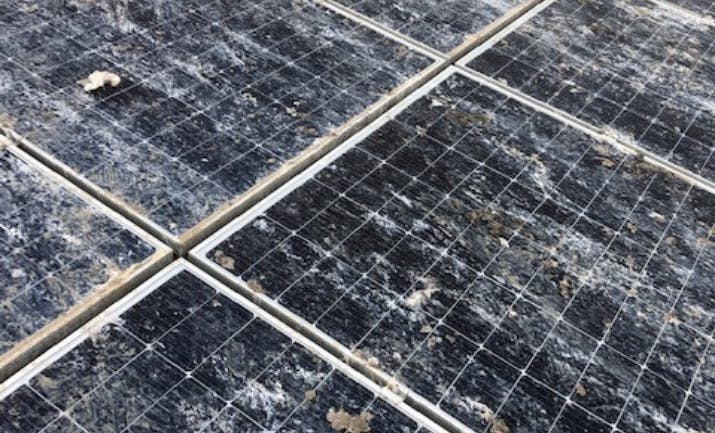
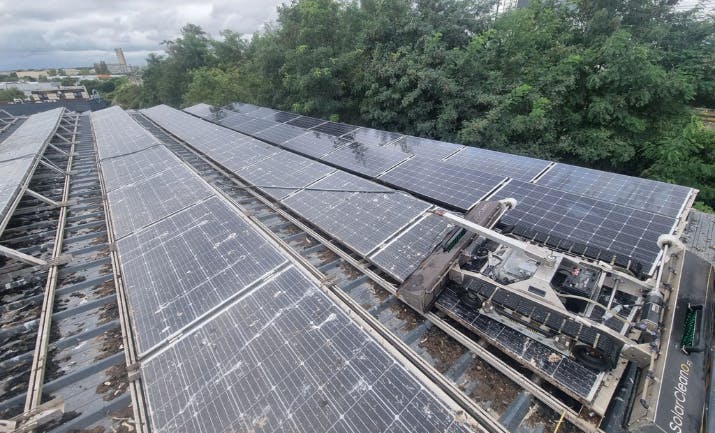
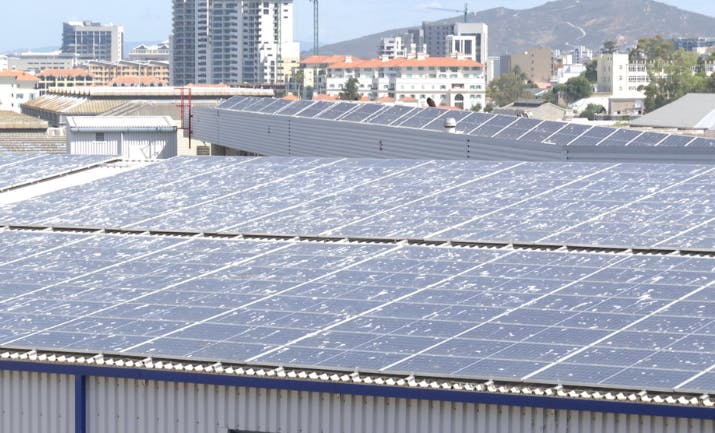
Dust and Environmental Pollution: Settling Stealthily
Airborne particles from dust and environmental pollution settle on solar panels, forming a thin layer over time. Wind can transport these particles over long distances, leading to their deposition on solar panels.
Their small size allows them to settle on the surfaces of solar panels and penetrate microscopic imperfections, making them harder to dislodge during cleaning.
This layer is often barely visible but can have a substantial impact on energy absorption. The cumulative effect of dust and pollution is a reduction in the amount of sunlight reaching the solar cells.
Due to this difficulty in perceiving dirt from dust or pollution, regular and thorough cleaning is crucial to maintain maximum performance. However, incorrect cleaning techniques can result in scratches or streaks on the panels.

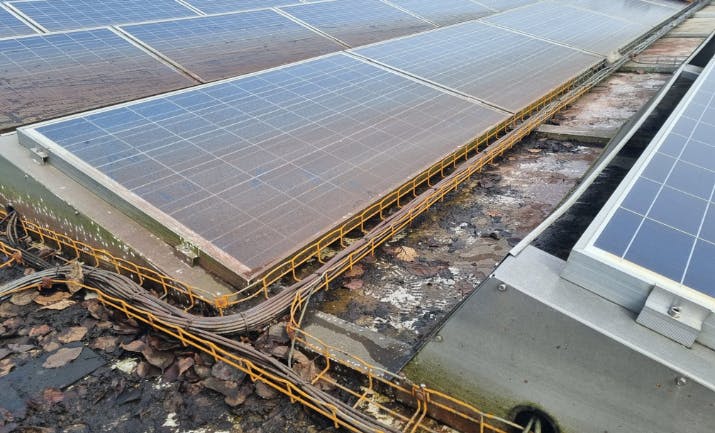

Cleaning tips
- Regular Cleaning Schedule - Implement a consistent cleaning routine to prevent the rapid buildup of contaminants on solar panels. Regular cleaning maintains the panel efficiency and facilitates easier removal.
- Use of cleaning solutions - Cleaning solutions suitable for solar modules have been specifically designed to solve this type of problem. Choose solar-module-friendly cleaning solutions, like Chemitek Solar's range, designed to effectively address each contaminant without causing damage. Ensure the solution is tested by reputable laboratories such as ÉMI-TÜV SÜD to guarantee the panel integrity and avoid warranty liability issues. Refrain from using harsh chemicals that could harm panel components, potentially voiding warranties. Opt for certified and tested solutions to safeguard your solar modules.
- Professional Cleaning Services - For deeply impregnated contaminants or uncertain situations, consider professional solar module cleaning services. Look for experienced professionals with the right equipment for safe and effective cleaning.
- Antisoiling Coatings - Implementing preventive measures, such as applying protective coatings, like ChemiTek’s ASA or D-Solar to create a barrier, minimizing contaminant adhesion. This preventive measure ensures easier and more effective future cleanings.
- No High-Pressure Cleaning! - Choose low-pressure cleaning methods over high-pressure alternatives to reduce the risk of damaging the panels. High-pressure water jets are forbidden by the manufacturers due to the risk of damaging the surface and blowing off the silicone seal (leading to water ingress in the panel).
- Use cleaning robots or soft bristle brushes for cleaning to avoid scratching or damaging the panel surface. While harder brushes may be necessary for aggressive contaminants, begin with soft bristles to ensure panel protection. Avoid abrasive materials like scrapers that can harm the module.
Sustaining Solar Performance
By understanding the specific threats posed by contaminants such as the five shown, lichens, fungi, cement dust, bird droppings and general pollution, the solar energy sector, operations and maintenance teams and solar panel owners can implement specific solutions, ensuring optimized cleaning and ease of maintenance.
Do you have any suggestions or topics about the solar universe you would like to read here? Reach us by email (and go solar)!
